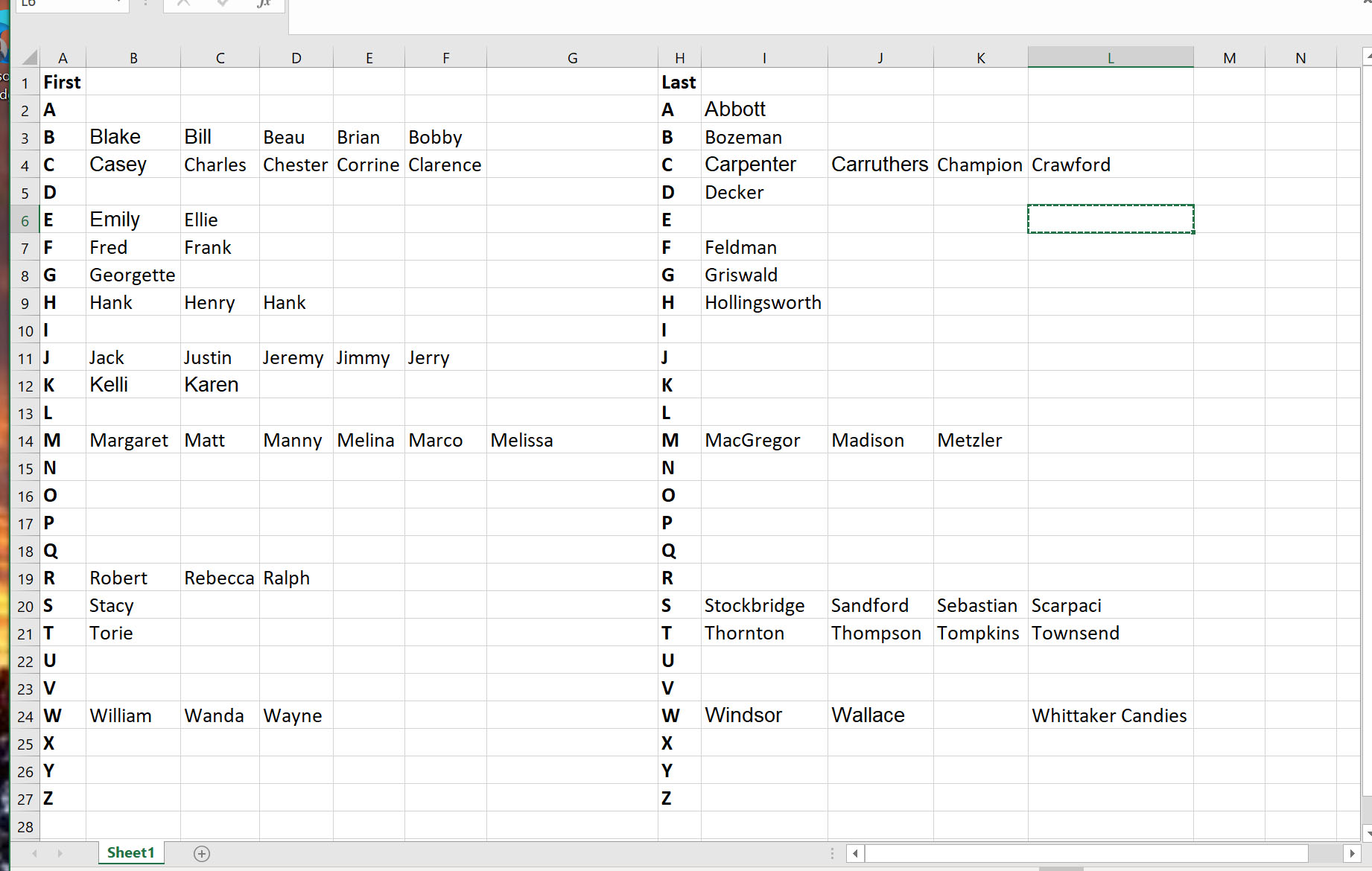Tips for Dealing With Character Names
Terry Odell
 Last week, John Gilstrap addressed coming up with character names, and there were a lot of helpful suggestions in the comments.
Last week, John Gilstrap addressed coming up with character names, and there were a lot of helpful suggestions in the comments.
I tend to hit the Google Machine. “Male (or female) Names Starting with …” is a frequent search. Another thing to add to that search is the year/decade that character was born. Name trends change with time.
I had a shocking realization when seeking a name for a character in a recent book.
Names have to “match” the characters to some extent. For me, it’s a loose match. Our country is so much of a melting pot that names often don’t match one’s ethnicity, and it’s often a stereotype to try to give them “appropriate” names. I recall my daughter, when she was in middle school, asking if her friend Kiesha could come visit. What’s your first visual? Probably not the blue-eyed blonde who showed up. But if I want an ethnic name, I just add that to my Google search.
This week, I thought I’d expand on John’s topic, because coming up with names is only part of the problem. You’ve cleared the choosing names for your characters hurdle. But there are pitfalls to avoid so you don’t confuse your readers.
A tip I picked up at a workshop was the reminder that the characters should sound like their parents named them, not you.
Major warning: Names shouldn’t be too similar to other characters in the book.
This mean no Jane and Jake, or Mick and Mack, or Michael and Michelle—and that includes nicknames. If everyone calls Michael Mike, and there’s another character named Norman, but Norman’s last name is MacDonald and everyone calls him Mac, then you’re setting things up for reader confusion. I recently read a book where the author had fixated on the letter B for character names, and these were major players, not bit parts. I don’t think I ever got them straight.
Many readers see the first few letters of a character’s name and connect it to whatever image they’ve created for that character. Your character might be named Anastasia, but the reader might be thinking “The blonde woman with the A name.”
So, how do you keep track so you don’t confuse or frustrate your readers? Here’s my system.
The late Jeremiah Healy prefaced one of his workshops with a very vocal complaint about character names in books. He said, “How hard is it to take a sheet of paper, write the alphabet in two columns, and then put first names in one, last names in the other?”
Now that we’re using computers, instead of a sheet of paper, I use a simple Excel spreadsheet. When I name a character, I fill in a blank field in the appropriate line. This lets me see at a glance when I start to fixate on a letter. I hadn’t been to Healy’s workshop when I wrote What’s in a Name? but when rights reverted to me, I used the spreadsheet and was shocked at what I’d discovered. THREE characters named Hank? Okay, only two, but the third was Henry “but you can call me Hank.” I still haven’t forgiven my then editor for that one.
This is what I found when I went through the book:
(You can click to enlarge the images)
 In addition to making minor revisions to the text, you can be sure I updated the character names. Here’s the “after” spreadsheet.
In addition to making minor revisions to the text, you can be sure I updated the character names. Here’s the “after” spreadsheet.
 Other considerations. Foreign names might be realistic, but what if a reader is unfamiliar with the name, or its pronunciation? One of my critique partners wrote a book with a family of Irish descent, and she’s calling one of the characters Siobhan. (If I were naming a character that, the first thing I’d do would be to set up an auto correct, because I’d probably spell it wrong more often than not.) But typing it right is the author’s problem, not the reader’s. Do you know how to pronounce Siobhan? (shi-VAWN) If the author tells you, when you see the word do you “hear it” or is it strictly a visual?
Other considerations. Foreign names might be realistic, but what if a reader is unfamiliar with the name, or its pronunciation? One of my critique partners wrote a book with a family of Irish descent, and she’s calling one of the characters Siobhan. (If I were naming a character that, the first thing I’d do would be to set up an auto correct, because I’d probably spell it wrong more often than not.) But typing it right is the author’s problem, not the reader’s. Do you know how to pronounce Siobhan? (shi-VAWN) If the author tells you, when you see the word do you “hear it” or is it strictly a visual?
(With apologies to Brother Gilstrap, I never see/hear his character Venice as Ven-EE-chay, no matter that he’s made the pronunciation clear. To me, she’s “Not Venice” in my head.)
And then, there’s a whole new set of problems. Audiobooks. When I started to put my books into audio, I had to focus on what things sound like as well as look like. In my third Triple-D Ranch book, the heroine’s ex-husband’s name is Seth. Her sister’s name is Bethany. They don’t look very similar on the page, but when spoken, I’m concerned that they’ll sound too much alike, especially if they’re in the same sentence. Or even paragraph. I don’t want my narrator stumbling (or calling them both Sethany).
All right, TKZers. Share your tips for keeping track of character names.
 Now available for Preorder. Trusting Uncertainty, Book 10 in the Blackthorne, Inc. series.
Now available for Preorder. Trusting Uncertainty, Book 10 in the Blackthorne, Inc. series.
You can’t go back and fix the past. Moving on means moving forward.
Terry Odell is an award-winning author of Mystery and Romantic Suspense, although she prefers to think of them all as “Mysteries with Relationships.” Follow her on Facebook and Twitter.
